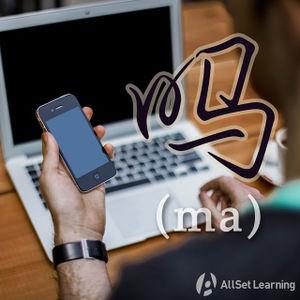Difference between revisions of "Advanced yes-no questions with "ma""
| Line 25: | Line 25: | ||
<div class="liju"> | <div class="liju"> | ||
*这 是 什么 ?<span class="pinyin">Zhè shì shénmei?</span><span class="trans">What is this?</span> | *这 是 什么 ?<span class="pinyin">Zhè shì shénmei?</span><span class="trans">What is this?</span> | ||
| − | *<strong> | + | *你 <strong>知道</strong> 这 是 什么 <em>吗</em>?<span class="pinyin">Nǐ <strong>zhīdào</strong> zhè shì shénme <em>ma</em>?</span><span class="trans">Do you know what this is?</span> |
| + | </div> | ||
| + | |||
| + | <div class="liju"> | ||
| + | *他 是 谁 ?<span class="pinyin">Tā shì shéi?</span><span class="trans">Who is he?</span> | ||
| + | *你 <strong>知道</strong> 他 是 谁 <em>吗</em>?<span class="pinyin">Nǐ <strong>zhīdào</strong> tā shì shéi <em>ma</em>?</span><span class="trans">Do you know who he is?</span> | ||
</div> | </div> | ||
| Line 34: | Line 39: | ||
<div class="liju"> | <div class="liju"> | ||
| − | * | + | *她 住 在哪儿 ?<span class="pinyin">Tā zhù zài nǎr?</span><span class="trans">Where does she leave?</span> |
| − | * | + | *她 <strong>说 过</strong> 她 住 在哪儿 <em>吗</em> ?<span class="pinyin">Tā <strong>shuō guo</strong> tā zhù zài nǎr <em>ma</em>?</span><span class="trans">Did she said where she lives?</span> |
</div> | </div> | ||
<div class="liju"> | <div class="liju"> | ||
| − | * | + | *这个 标志 是 什么 意思 ?<span class="pinyin">Zhège biāozhì shì shénme yìsi?</span><span class="trans">What does this sign mean?</span> |
| − | * | + | *你们 <strong>理解</strong> 这个 标志 是 什么 意思 <em>吗</em>?<span class="pinyin">Nǐmen <strong>lǐjiě</strong> zhège biāozhì shì shénme yìsi <em>ma</em>?</span><span class="trans">Do you understand what this sign means?</span> |
</div> | </div> | ||
Revision as of 04:41, 16 October 2017
-
Level
-
Similar to
-
Used for
-
Keywords
The question particle 吗 (ma) is a very simple way to convert it into a "yes/no question," and beginners will learn not to use 吗 with other question words, because it's redundant. More advanced students, however, will note that 吗 has some more complicated structures that do involve combining it with question words in order to ask very specific types of confirming questions.
Structure
You'll remember that this is the simple pattern for yes/no questions:
Statement + 吗 ?
If you embed a question that uses a question word instead of a statement, you can create a more complex kind of "confirming" 吗 (ma) question:
[Question Word] + 吗 ?
Examples of common question words include 什么 (shénme), 谁 (shéi), and 哪里 (nǎlǐ).
Examples
Note that the following examples typically contains some kind of "verb of understanding" such as 知道 (zhīdào),了解 (liǎojiě), 明白 (míngbai), 认识 (rènshi), etc. Then "吗" (ma) can still be added at the end of the question, turning it into a kind of confirmation. For example:
- 这 是 什么 ?What is this?
- 你 知道 这 是 什么 吗?Do you know what this is?
- 他 是 谁 ?Who is he?
- 你 知道 他 是 谁 吗?Do you know who he is?
- 他 叫 什么 名字 ?What is his name?
- 你 知道 他 叫 什么 名字 吗?Do you what his name is?
- 她 住 在哪儿 ?Where does she leave?
- 她 说 过 她 住 在哪儿 吗 ?Did she said where she lives?
- 这个 标志 是 什么 意思 ?What does this sign mean?
- 你们 理解 这个 标志 是 什么 意思 吗?Do you understand what this sign means?
- 我们 想 要 什么 ?What do we want?
- 他 问 过 我们 想 要 什么 吗?Did he care to ask what we want?
- 你 的 问题 是 什么 ?What is your question?
- 你 能 再 说 一 遍 你 的 问题 是 什么 吗 ?Can you repeat what your question is?
- 他 是 什么 时候 开始 学 中文 的 ?When did he started to learn Chinese?
- 你 知道 他 是 什么 时候 开始 学 中文 的 吗 ?Do you know when he started to learn Chinese?
- 这 是 在哪儿 买 的 ?Where did you buy this?
- 你 能 告诉 我 这 是 在哪儿 买 的 吗 ?Can I tell me where you bought this?
See also
Sources and further reading
Books
- Chinese: An Essential Grammar, Second Edition (pp. 138-40) →buy
- Integrated Chinese: Level 1, Part 1 (3rd ed) (pp. 29-30) →buy
- New Practical Chinese Reader 1 (新实用汉语课本1) (p. 21) →buy
- New Practical Chinese Reader 1 (新实用汉语课本1)(2nd ed) (pp. 23, 250) →buy



